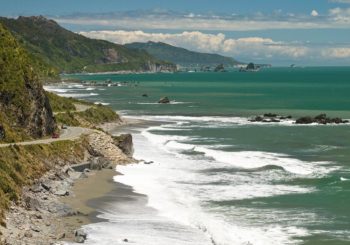Roman Warm Period Was 3.6°F Warmer Than Today, New Study Shows
The Mediterranean Sea was 3.6°F (2°C) hotter during the Roman Empire than other average temperatures at the time, a new study claims.
The Empire coincided with a 500-year period, from AD 1 to AD 500, which was the warmest period of the last 2,000 years in the almost completely land-locked sea.
The climate later progressed towards colder and arid conditions that coincided with the historical fall of the Empire, scientists claim.
Spanish and Italian researchers recorded ratios of magnesium to calcite taken from skeletonized amoebas in marine sediments, an indicator of seawater temperatures, in the Sicily Channel.
They say the warmer period may have also coincided with the shift from the Roman Republic to the great Empire founded by Octavius Augustus in 27 BC.
The study offers ‘critical information’ to identify past interactions between climate changes and the evolution of human societies and ‘their adaptive strategies’.
It meets requests from the Intergovernmental Panel on Climate Change (IPCC) to assess the impact of historically warmer conditions between 2.7°F and 3.6°F (1.5°C to 2°C).
However, the historical warming of the Med during the Roman Empire is linked to intense solar activity, which contrasts with the modern threat of greenhouse gases.

The study identifies the Roman period (1-500 AC) as the warmest period of the last 2,000 years. Map A shows the central-western Mediterranean Sea. The red triangle shows the location of the sample studied, while the red circles are previously-found marine records used for the comparison. Map B shows the Sicily Channel featuring surface oceanographic circulation and sample location. Black lines follow the path of surface water circulation
‘For the first time, we can state the Roman period was the warmest period of time of the last 2,000 years, and these conditions lasted for 500 years,’ said Professor Isabel Cacho at the Department of Earth and Ocean Dynamics, University of Barcelona.
The Mediterranean is a semi-closed sea, meaning it is surrounded by land and almost only connected to oceans by a narrow outlet, and is a climate change ‘hot spot’ according to a previous paper.
Situated between North Africa and European climates, the sea occupies a ‘transitional zone’, combining the arid zone of the subtropical high and humid northwesterly air flows.
This makes it extremely vulnerable to modern and past climate changes, such as changes in precipitation change and average surface air temperature and is of ‘particular interest’ to researchers.
Home to many civilizations over the years, the Med, or Mare Nostrum as it was known by ancient Roman civilizations, has become a model to study the periods of climate variation.
Reconstructing previous millennia of sea surface temperatures and how it evolved is challenging, due to the difficulty retrieving good resolution marine records.
However, the study of the fossil archives remains the only valid tool to reconstruct past environmental and climatic changes as far back as 2,000 years ago, they say.

Comparison of the records from Sicily Channel studied in this work (thick dark blue line) in comparison with other samples – Alboran Sea (thick light blue line), Minorca Basin (thick red line), and the Aegean Sea (thick dark and light green lines). They support the claim that the Roman Period saw a 3.6°F rise in temperatures in the Med
Turning to another method, experts analyzed the ratios of magnesium to calcite taken from samples of single-celled protists called foraminifera, which is found in all marine environments.
In particular, the species Globigerinoides ruber, present in marine sediments, is an indicator of seawater temperatures.
Researchers took the skeletonized G. ruber sampled from a depth of 1,500 feet (475m) located in the northwestern part of the Sicily Channel.
It was recovered during a 2014 oceanographic expedition onboard the RV CNR-Urania research vessel.
These unicellular organisms, part of the marine zooplankton, have a specific habitat limited to the surface layers of the water column.
‘Therefore, the chemical analysis of its carbonated skeleton allows us to reconstruct the evolution of the temperature of the surface water mass over time,’ said Professor Cacho.
Compared to the subsequent period of the Roman Empire, the Mediterranean was characterized by a colder phase from around 500 BC to 200 BC.
This corresponds with the beginning of the so-called ‘sub-Atlantic phase’ characterized by a cool climate and rainy winters, which were favorable for Greek and Roman civilizations to grow crops.
The cool and humid climate of the sub-Atlantic phase lasted until around 100 BC and covered the entire period of the monarchy in Rome.
However, in 400 BC, cultural changes were synchronized across the Mediterranean region and more ‘homogeneous’ temperature conditions across the Med regions were established.
A distinct warming phase, running from AD 1 to AD 500, then coincided with the Roman Period and covered the whole Roman Empire archaeological period.
‘This pronounced warming during the Roman Period is almost consistent with other marine records from the Atlantic Ocean,’ the team say in their research paper, published in
Scientific Reports.
This climate phase corresponds to what is known as the ‘Roman Climatic Optimum’ characterized by prosperity and expansion of the Empire, giving warmth and sunlight to crops.
Roman Climatic Optimum, a phase of warm stable temperatures across much of the Mediterranean heartland, covers the whole phase of origin and expansion of the Roman Empire.
The greatest time of the Roman Empire coincided with the warmest period of the last 2,000 years in the Mediterranean.
After the Roman Period, a general cooling trend developed in the region with several minor oscillations in temperature.
The climate then transitioned from wet to arid conditions and this could have marked the decline of the golden period of the Roman Empire after AD 500.
These new records correlated with data from other areas of the Mediterranean – the Alboran Sea, Menorca basin, and the Aegean Sea.
‘We hypothesize the potential link between this Roman Climatic Optimum and the expansion and subsequent decline of the Roman Empire.’
The study provides high resolution and precision data on how the temperatures evolved over the last 2,000 years in the Mediterranean area.
It also identifies a warming phase that’s different during the Roman Empire in the Mediterranean area and is focused on the reconstruction of the sea surface temperature over the last 5,000 years.
Read rest at Daily Mail






























